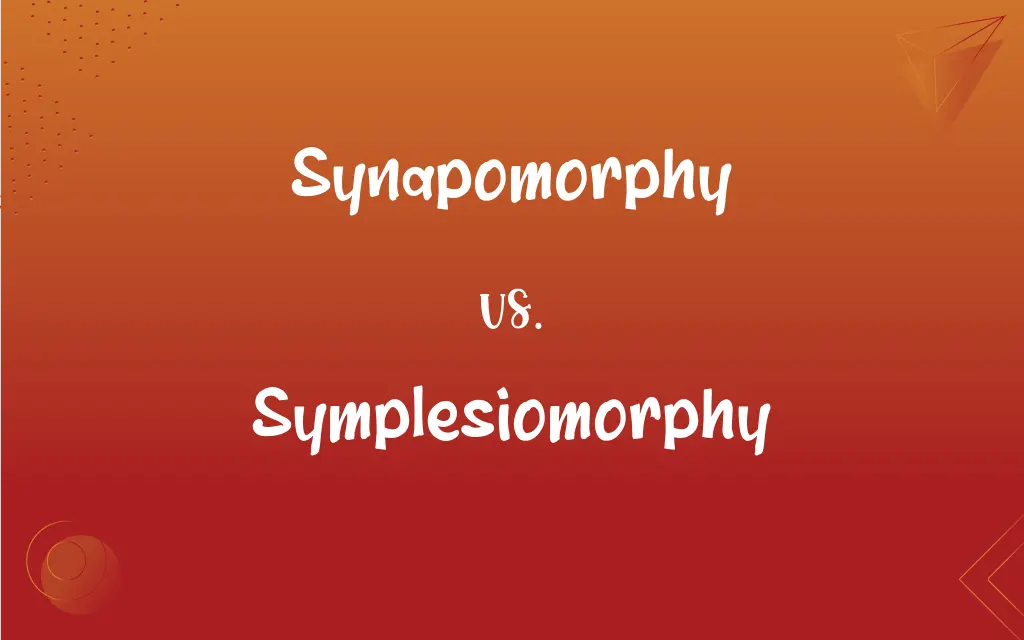Synapomorphy vs. Symplesiomorphy: What's the Difference?
Edited by Aimie Carlson || By Harlon Moss || Published on February 22, 2024
Synapomorphy is a trait unique to a certain group and its descendants, while symplesiomorphy is an ancestral trait shared by multiple groups.

Key Differences
Synapomorphy refers to a derived characteristic or trait that is unique to a particular group and its descendants, signifying a recent evolutionary change. It's a hallmark of evolutionary relationships, used to define clades in phylogenetic trees. Symplesiomorphy, on the other hand, is a shared ancestral trait found in multiple groups, indicating a more distant common ancestry. It's less useful for determining current evolutionary relationships, as it reflects older commonalities.
In synapomorphy, the trait is a relatively new evolutionary development, distinguishing a specific group or species from its ancestors and other groups. For instance, feathers in birds are a synapomorphy that separates them from other vertebrates. In contrast, symplesiomorphy involves traits that were present in distant ancestors and are retained in multiple descendant groups. For example, the presence of a backbone in birds and mammals is a symplesiomorphy, not distinguishing them from each other but linking them to a more distant common ancestor.
Synapomorphies are pivotal in cladistics, a method of classifying organisms based on common descent, as they pinpoint the evolutionary branch where a new trait emerged. Identifying synapomorphies helps scientists accurately trace the evolutionary history of a group. Conversely, symplesiomorphies, being older shared traits, can be misleading in cladistics if not properly identified, as they can suggest a closer relationship between groups than actually exists.
Synapomorphy is key in defining monophyletic groups (true clades), which include an ancestor and all its descendants. This characteristic is newly evolved in the ancestor and passed down. Symplesiomorphy, however, is a trait inherited from an older common ancestor and found in more than one descendant group, thus often seen in paraphyletic or polyphyletic groups, which do not include all descendants of a common ancestor.
Understanding synapomorphy is crucial for evolutionary biologists in reconstructing phylogenies and understanding how species diverge from common ancestors. Symplesiomorphy, while important in understanding broader evolutionary patterns, is less informative for recent evolutionary events or for distinguishing closely related species.
ADVERTISEMENT
Comparison Chart
Definition
Unique trait to a group and its descendants
Ancestral trait shared by multiple groups
Evolutionary Relevance
Indicates recent evolutionary divergence
Reflects more distant common ancestry
Use in Cladistics
Defining and distinguishing clades
Can be misleading for determining relationships
Example
Feathers in birds
Backbone in birds and mammals
Phylogenetic Role
Identifies specific evolutionary changes
Highlights broad, ancestral traits
ADVERTISEMENT
Synapomorphy and Symplesiomorphy Definitions
Synapomorphy
A characteristic or feature present in an ancestral species and shared exclusively by its evolutionary descendants.
The presence of a marsupial pouch in kangaroos and other marsupials is a synapomorphy.
Symplesiomorphy
A primitive or ancestral feature present in a group of organisms.
Having five digits on each limb is a symplesiomorphy among many vertebrates.
Synapomorphy
A unique feature used to define a clade within a phylogenetic tree.
Birds' ability to fly is a synapomorphy that differentiates them from other vertebrates.
Symplesiomorphy
An older evolutionary trait shared by a group, not useful for determining recent phylogenetic relationships.
The ability to breathe air is a symplesiomorphy for both amphibians and mammals.
Synapomorphy
A derived trait that sets a clade apart from other organisms.
Opposable thumbs are a synapomorphy distinguishing primates from other mammals.
Symplesiomorphy
A trait inherited from a remote ancestor, common to a wider range of species.
Cold-bloodedness is a symplesiomorphy seen in both fish and reptiles.
Synapomorphy
A trait or characteristic that evolved in the lineage leading up to a clade and is unique to that clade.
The development of a four-chambered heart is a synapomorphy among mammals.
Symplesiomorphy
An ancestral trait shared by two or more taxa.
The presence of a tail in reptiles and mammals is a symplesiomorphy.
Synapomorphy
An evolutionary novelty or derived trait observed in a last common ancestor and its descendants.
Flowering in angiosperms is a synapomorphy distinguishing them from non-flowering plants.
Symplesiomorphy
A characteristic found in an ancestor and its descendants, but not diagnostic of a particular evolutionary lineage.
Vertebrates sharing a bony spine is an example of a symplesiomorphy.
Synapomorphy
An evolved character or trait that is shared by two or more taxonomic groups and is considered to have originated in their common ancestor. Hair is synapomorphic for marsupials, primates, and all other taxa that are grouped together in the class Mammalia.
Symplesiomorphy
(cladistics) An ancestral trait shared by two or more taxa.
Synapomorphy
(cladistics) A derived trait that is shared by two or more taxa of shared ancestry.
FAQs
Why is synapomorphy important in biology?
It helps define and distinguish evolutionary clades, aiding in the reconstruction of phylogenetic trees.
Can symplesiomorphy be misleading in cladistics?
Yes, because it suggests broader, older commonalities, it may imply closer relationships than actually exist.
What is symplesiomorphy?
Symplesiomorphy is an ancestral trait shared by multiple groups, reflecting more distant common ancestry.
What's an example of a synapomorphy?
The presence of feathers in birds is a synapomorphy.
What is synapomorphy?
Synapomorphy is a derived trait unique to a certain group and its descendants, indicating recent evolutionary changes.
Is symplesiomorphy useful for identifying recent evolutionary relationships?
No, it's more useful for understanding broader, older evolutionary patterns.
How does synapomorphy assist in understanding evolution?
It identifies specific evolutionary changes and divergence points in species.
Is identifying synapomorphies subjective?
It can be, but it's generally based on scientific evidence and analysis.
What's an example of a symplesiomorphy?
The backbone in both birds and mammals is a symplesiomorphy.
Can a trait be both a synapomorphy and a symplesiomorphy?
No, as synapomorphy is a unique derived trait, while symplesiomorphy is an older, shared ancestral trait.
Are synapomorphies always visible traits?
Not necessarily, they can be morphological, behavioral, or molecular.
Is symplesiomorphy useful for defining clades?
No, because it reflects ancestral traits common to multiple groups.
Are behavioral traits considered in synapomorphy?
Yes, behavioral changes can also be unique to certain groups.
Can symplesiomorphy inform about evolutionary history?
Yes, it provides insights into distant evolutionary relationships.
Are synapomorphies always species-specific?
They are specific to a group or clade, which may include multiple species.
How do scientists identify synapomorphies?
Through comparative anatomy, genetics, and fossil records.
Can symplesiomorphies evolve into synapomorphies?
No, as synapomorphies are newly derived traits, not ancient ones.
Can molecular characteristics be synapomorphies?
Yes, molecular features can also be unique to certain groups.
Do synapomorphies evolve independently in different groups?
No, they are traits that have evolved once in a common ancestor.
Are all shared traits among species symplesiomorphies?
Only if they are inherited from a distant common ancestor.
About Author
Written by
Harlon MossHarlon is a seasoned quality moderator and accomplished content writer for Difference Wiki. An alumnus of the prestigious University of California, he earned his degree in Computer Science. Leveraging his academic background, Harlon brings a meticulous and informed perspective to his work, ensuring content accuracy and excellence.
Edited by
Aimie CarlsonAimie Carlson, holding a master's degree in English literature, is a fervent English language enthusiast. She lends her writing talents to Difference Wiki, a prominent website that specializes in comparisons, offering readers insightful analyses that both captivate and inform.






































































